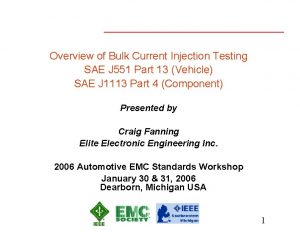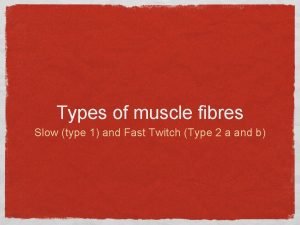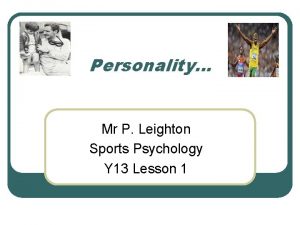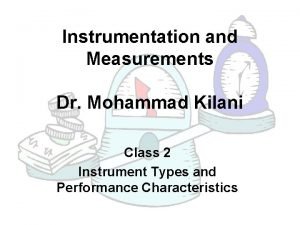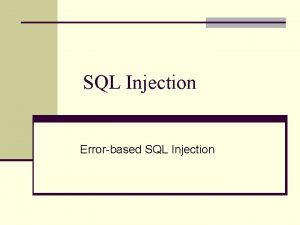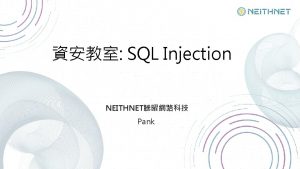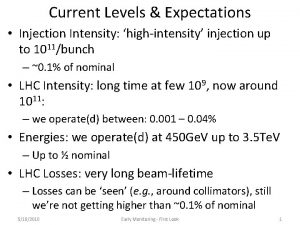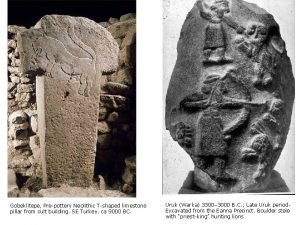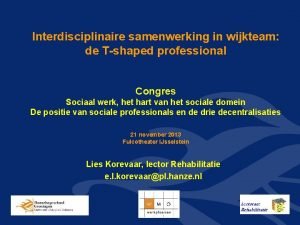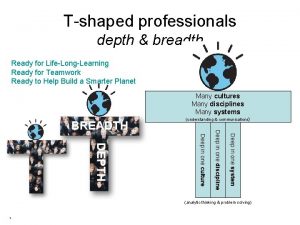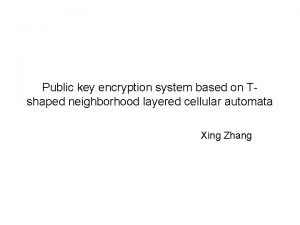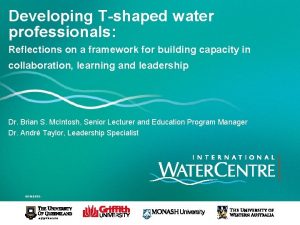Lasing properties of ArmStem type current injection Tshaped


























- Slides: 26

Lasing properties of Arm-Stem type current injection T-shaped quantum wire lasers ISSP Univ. of Tokyo M 2 Makoto Okano 1. Background and Motivation 2. Structure of current injection QWR 3. Lasing properties of QWR 4. Mechanism of current injection 5. Summary

0. Introduction ~about T-shaped QWR

0. Introduction ~about T-shaped QWR ↑Merits:High uniformity & High controllability of structure. ↓Demerit:Difficulty of fabrication.

1. Background and Motivation It is expected that quantum wire laser become better than quantum well laser. ↓ Lasing from current injection T-shaped quantum wire (T-wire) had been reported by W. Wegscheider et al. in 1994. However, there has ever been no concrete detail. ↓ Recently, we developed growth interrupt annealing technique in 2001. This technique makes T-wire high uniformity possible. ↓ We make high uniformity current injection T-wire with the technique, and measure lasing properties of current injection T -wire laser. And then, verify the effects of 1 D. Advantage: Directly estimate carrier density from current. Easy to measure external quantum efficiency.

2 -1. Schemata of two current injection electron through Arm well hole through stem well hole through Arm well Arm-Stem type Arm-Arm type

2 -1. Schemata of two current injection device properties 15 Number of wires 20 5~110 K Operating temp. 30~70 K 2. 0 m. A at 100 K Threshold current 0. 27 m. A at 30 K 0. 9% at 100 K External quantum efficiency 12% at 30 K

2 -2. Structure of Arm-Stem type

3. Lasing properties (with HR/HR coating) T=100 K EL spectra I-V, I-L curve Temperature dependence of Ith and ηout 100 K is the best conditions for Ith and ηout. (effect of transport? ) This feature is different than that of Arm-Arm type

I have two questions. 1. Why do Arm-Stem type performs best at 100 K? 2. 2. Why is threshold ten times as large as arm-arm type’s? 3. ↓ 4. So, I have measured un-coated sample in region of low current to develop a thorough understanding of these problems.

4 -1. EL spectra with low current (un coated) un-coated EL intensity become strong, but lineshape don’t change.

4 -2. Absorption/gain spectra with low current un-coated cf. Optical pumping Current increase gradually, but gain spectra don’t change. Probably, carrier increase imbalance in wire. (Nelectron=Nhole)

4 -3. Bias-Voltage depend. of EL Image Ib = 10 u. A Vb=1. 64 V Emission from core layer mainly Emission from outside of the cladding layer Ib =2. 0mA Vb=4. 19 V hole accumulation and overflow from core.

4 -4. Carrier confinement and injection Conventional schema Hole overflow in arm well because of weak confinement.

4 -4. Carrier confinement and injection Inversion schema Are hole confined because of high barrier of stem well?

5. Summary 1. We achieved lasing from Arm-Stem type current injection T-wire lasers. But, device properties are not good. And it performs best at 100 K. 2. Injection efficiency is bad 3. Strange temperature dependence New schema may make it well. Effect of carrier transport? 2. When current increase gradually, EL intensity increase and gain spectra don’t change. We assumed because of hole accumulation and hole overflowing. Future prospects 1. Measure the uncoated sample, and check the change in gain spectra. 2. Measure the new schema sample, and compared the old schema.

Fin. Thank you for your kind attention. See you next time…








高電流時(Ib=2. 0 m. A)のEL-Image

低電流時(Ib=10 u. A)のEL-Image

 Ano ang dalawang bahagi ng matandang panitikan?
Ano ang dalawang bahagi ng matandang panitikan? Bulk current injection testing
Bulk current injection testing Line currents
Line currents Line current and phase current
Line current and phase current Energy band diagram of pnp transistor
Energy band diagram of pnp transistor Lesson 4 three-phase motors
Lesson 4 three-phase motors Drift vs diffusion current
Drift vs diffusion current Ceramic composition resistors
Ceramic composition resistors The constant-current region of a fet lies between
The constant-current region of a fet lies between Line currents
Line currents Holding current and latching current
Holding current and latching current Diffusion current formula
Diffusion current formula Why must the electrode holder be correctly sized
Why must the electrode holder be correctly sized Hazard based safety engineering
Hazard based safety engineering Kcl mesh analysis
Kcl mesh analysis Which type of diesel injection produces less noise
Which type of diesel injection produces less noise Extensive vs intensive properties
Extensive vs intensive properties Physical properties and chemical properties
Physical properties and chemical properties Is hyper v type 1 or type 2
Is hyper v type 1 or type 2 Aceytlcholine
Aceytlcholine Type i error
Type i error Type 1 error vs type 2 error example
Type 1 error vs type 2 error example How can one type of rock change into another type of rock?
How can one type of rock change into another type of rock? Type a and type b personality theory
Type a and type b personality theory Sublimation defense mechanism
Sublimation defense mechanism Myotonic dystrophy type 1 vs type 2
Myotonic dystrophy type 1 vs type 2 Non smart instruments
Non smart instruments

